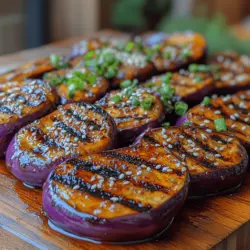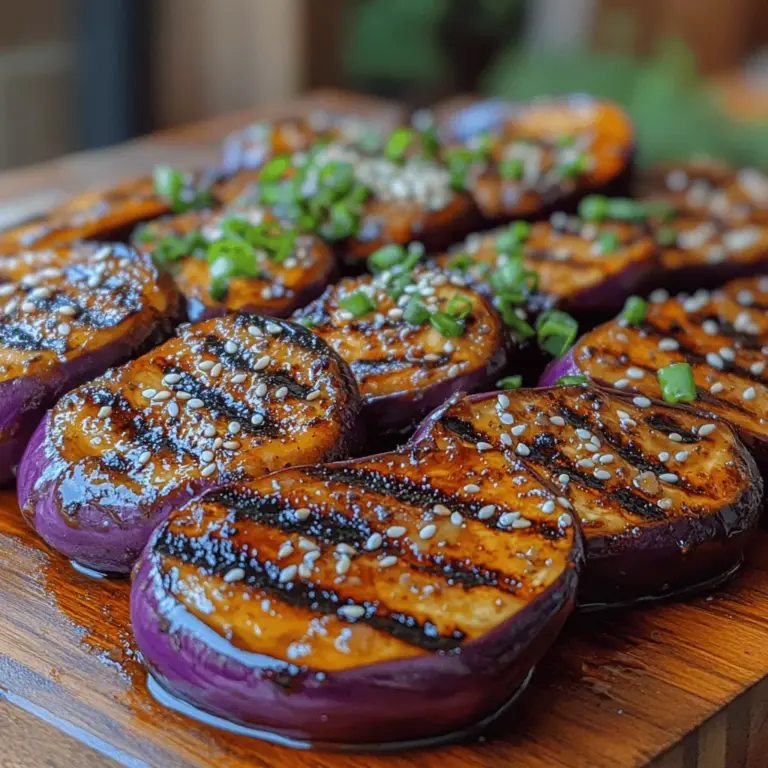Introduction
Miso glazed eggplant is a culinary delight that marries the rich, umami flavors of miso with the tender, creamy texture of roasted eggplant. This dish shines as a delicious and healthy option, perfect for those seeking to enhance their plant-based repertoire or simply enjoy a satisfying side dish. Miso, a fermented soybean paste, brings depth to the dish, while eggplant serves as a versatile canvas that soaks up the savory glaze beautifully.
Eggplant, also known as aubergine, plays a pivotal role in various cuisines around the world, particularly within Asian cooking. From the spicy dishes of Sichuan cuisine to the comforting stews of Japanese fare, eggplant’s adaptability makes it a beloved ingredient. Its ability to absorb flavors allows it to shine in this miso-glazed preparation, where the sweet and salty notes of the miso complement the vegetable’s natural taste.
The unique flavor profile of miso glazed eggplant is what truly sets this dish apart. The combination of earthy miso, with its hint of sweetness and saltiness, enhances the eggplant’s inherent nuttiness. Nutritionally, both miso and eggplant pack a punch: miso is rich in probiotics and essential nutrients, while eggplant is low in calories and high in dietary fiber. Together, they create a dish that is not only satisfying but also beneficial for your health.
Understanding Miso and Its Varieties
Miso is a traditional Japanese ingredient that has been celebrated for centuries, dating back to at least the 7th century. This fermented soybean paste is created through a process that involves the fermentation of soybeans with salt and a specific type of mold known as koji. The result is a versatile condiment that can be used in everything from soups to marinades, adding a complex, savory depth to dishes.
There are several varieties of miso, each with its unique flavor profile and culinary applications. The most common types include:
– White Miso (Shiro Miso): This type of miso is made with a higher proportion of rice and has a mild, sweet flavor. It’s ideal for dressings, marinades, and lighter dishes, making it the perfect choice for our miso glazed eggplant.
– Red Miso (Aka Miso): Made from fermented soybeans, red miso has a stronger, saltier flavor due to a longer fermentation period. It works well in hearty dishes and stews.
– Mixed Miso (Awase Miso): This is a blend of both white and red miso, combining the sweetness of white with the depth of red, and is often used for a variety of applications.
The health benefits of miso are notable. Not only is it a source of protein, but it also contains probiotics that support gut health. Miso is rich in vitamins and minerals, including vitamin K, manganese, and zinc, making it a nutritious addition to any meal. Its fermentation process enhances its digestibility, allowing your body to absorb its nutrients more efficiently.
Eggplant: A Versatile Vegetable
Eggplant is more than just a tasty vegetable; it’s a nutritional powerhouse. Low in calories and high in dietary fiber, eggplant is a fantastic choice for those looking to maintain a healthy diet. It’s packed with antioxidants, particularly nasunin, which is known for its potential neuroprotective properties. This makes eggplant not only delicious but also a great ally in promoting overall health.
When it comes to varieties, eggplants come in various shapes, sizes, and colors. The two most popular types are:
– Japanese Eggplants: These are slender, elongated, and have a more delicate flavor compared to their globe counterparts. Their tender skin and fewer seeds make them perfect for dishes like miso glazed eggplant, as they cook quickly and absorb flavors beautifully.
– Globe Eggplants: These are the larger, rounder varieties often found in Mediterranean cooking. They have a thicker skin and are slightly more bitter than Japanese eggplants.
Choosing the right eggplant is crucial for the success of your dish. Look for eggplants that are firm to the touch, with shiny, smooth skin. Avoid any that have blemishes or soft spots, as these can indicate overripeness. If possible, select smaller eggplants, which tend to be sweeter and less bitter.
Ingredient Breakdown
To create the perfect miso glazed eggplant, you’ll need a handful of quality ingredients. Here’s a detailed description of each:
– Eggplant: As mentioned, Japanese eggplants work best for this recipe due to their tender texture and ability to absorb flavors. Aim for 2-3 medium-sized eggplants.
– White Miso Paste: The star of the dish, white miso adds sweetness and umami. Look for a high-quality brand that uses organic ingredients, which can enhance the flavor and nutritional value.
– Mirin: This sweet rice wine brings a hint of sweetness to the glaze and balances the saltiness of the miso. If you’re looking for an alcohol-free option, you can substitute mirin with a mixture of rice vinegar and a little sugar.
– Soy Sauce: A splash of soy sauce adds depth and saltiness to the glaze. For a gluten-free option, consider using tamari.
– Sesame Oil: This oil not only adds a nutty flavor but also enhances the dish’s richness. Choose toasted sesame oil for a more robust flavor.
– Sugar or Maple Syrup: A touch of sweetener helps to balance the savory elements of the miso and soy sauce. You can use granulated sugar, brown sugar, or maple syrup based on your dietary preferences.
– Green Onions and Sesame Seeds: These are optional garnishes that add freshness and crunch to the finished dish.
When it comes to ingredient quality, it’s important to choose fresh, organic produce and high-quality condiments. The flavor of your miso glazed eggplant will be significantly influenced by the ingredients you select, so take the time to source the best options available.
Preparation Steps for Miso Glazed Eggplant
Now that you have a grasp of the background and ingredients, it’s time to delve into the preparation steps for miso glazed eggplant. This method ensures that the eggplant is not only flavorful but also retains its lovely texture.
1. Preheat the Oven: Start by preheating your oven to 400°F (200°C). This ensures that the eggplant cooks evenly and develops a beautiful caramelization.
2. Prepare the Eggplant: Wash the eggplants thoroughly and slice them in half lengthwise. To help reduce bitterness and improve texture, you can sprinkle the cut sides with salt and let them sit for about 20-30 minutes. This draws out excess moisture and bitterness.
3. Make the Miso Glaze: In a small bowl, whisk together the white miso paste, mirin, soy sauce, sesame oil, and your choice of sweetener until smooth. The glaze should have a thick but pourable consistency. Adjust the sweetness to your preference, keeping in mind that the final dish will have a balance of savory and sweet flavors.
4. Rinse and Pat Dry: After the eggplants have rested, rinse off the salt under cold water and pat them dry with paper towels. This step is crucial to avoid an overly salty final dish.
5. Coat the Eggplant: Place the eggplant halves cut-side up on a baking sheet lined with parchment paper. Brush a generous amount of the miso glaze over the cut sides, ensuring they are well-coated. Reserve some glaze for later to brush on during the cooking process.
6. Roast the Eggplant: Place the baking sheet in the preheated oven and roast the eggplant for about 20 minutes. After the first 10 minutes, remove the baking sheet and brush on the remaining glaze. This additional layer of glaze will create a rich, caramelized exterior.
7. Finish Cooking: Return the eggplant to the oven and roast for an additional 10-15 minutes, or until the eggplant is tender and the glaze is bubbling and slightly caramelized. The edges should be golden brown, indicating that the flavors have melded beautifully.
With these steps, you’re on your way to creating a stunning dish that showcases the wonderful flavors of miso and eggplant. The combination of preparation methods and quality ingredients ensures that each bite is packed with flavor and nutrition.
Stay tuned for the next part of this article, where we will delve into tips for achieving the best results with your miso glazed eggplant and answer some common questions about this delightful dish.
{{image_2}}
Preparation of Eggplants
Before diving into the cooking process, it’s essential to prepare the eggplants properly. One of the most crucial steps is salting and resting the eggplants, a technique that enhances both their flavor and texture.
Why Salting is Important?
Salting eggplants removes excess moisture and bitterness, allowing them to absorb the miso glaze more effectively. To salt your eggplants, simply slice them into rounds or halves, depending on your preference, and sprinkle a generous amount of salt over them. Let them rest for about 30 minutes. You’ll notice beads of moisture forming on the surface; this is a good sign that the salting process is working. After resting, rinse the eggplant slices under cold water to wash off the salt and pat them dry with paper towels. This step ensures that your eggplants are flavorful without being overly salty.
Crafting the Miso Glaze
Creating a miso glaze is a straightforward process, but it requires attention to detail to achieve the perfect balance of flavors. Here’s a step-by-step guide to making a smooth and flavorful miso glaze:
1. Gather Ingredients: You will need:
– ¼ cup white miso paste
– 2 tablespoons mirin (a sweet rice wine)
– 1 tablespoon rice vinegar
– 1 tablespoon soy sauce (or tamari for gluten-free)
– 1 tablespoon sesame oil
– 1 tablespoon maple syrup or honey (optional for added sweetness)
– 1 teaspoon grated ginger (for an extra zing)
2. Mix the Elements: In a bowl, combine the white miso paste, mirin, rice vinegar, soy sauce, sesame oil, and maple syrup or honey. Whisk until the mixture is smooth and well combined. If you prefer a thinner glaze, you can add a tablespoon of water until you reach your desired consistency.
3. Taste and Adjust: Always taste your glaze. If it requires more sweetness, add a bit more maple syrup or honey. For a more robust flavor, consider adding a touch more soy sauce or ginger. This glaze not only enhances the eggplant but can also be used for other vegetables and proteins.
Cooking Methods: Grilling vs. Baking
When it comes to cooking miso glazed eggplant, you have two primary methods to choose from: grilling and baking. Each method has its pros and cons.
Grilling:
Grilling imparts a smoky flavor and beautiful grill marks that enhance the presentation. The high heat of the grill caramelizes the sugars in the glaze, resulting in a deliciously charred exterior. However, grilling requires more attention to prevent burning and can be less forgiving for those less experienced.
Baking:
Baking is a simpler and more hands-off method. You can roast multiple pieces of eggplant at once without needing to monitor them closely. Baking also allows for even cooking, though it may not produce the same smoky flavor as grilling.
Cooking the Eggplant to Perfection
Regardless of the cooking method you choose, achieving the perfect texture and flavor is key. Here are detailed cooking instructions for both grilling and baking:
Grilling Instructions:
1. Preheat the Grill: Aim for medium-high heat, around 400°F (204°C).
2. Prep the Eggplants: Brush each slice of eggplant lightly with oil to prevent sticking.
3. Apply the Miso Glaze: Generously coat each eggplant piece with the miso glaze, ensuring an even spread.
4. Grill: Place the eggplant on the grill. Cook for about 4-5 minutes on each side, basting with more glaze halfway through. Look for those beautiful grill marks and caramelization.
5. Check for Doneness: The eggplant should be tender and slightly charred. You can use a fork or knife to check.
Baking Instructions:
1. Preheat the Oven: Set to 400°F (204°C).
2. Prepare the Baking Sheet: Line a baking sheet with parchment paper for easy cleanup.
3. Prepare the Eggplants: Brush each slice with oil and coat with the miso glaze.
4. Bake: Place the eggplant slices on the baking sheet in a single layer. Bake for 20-25 minutes, flipping halfway through and basting with more glaze.
5. Check for Doneness: The eggplant should be soft and starting to caramelize on the edges.
Tips for Achieving the Perfect Caramelization and Grill Marks
– Don’t Overcrowd the Grill or Baking Sheet: Give each piece enough space to cook evenly.
– Oil the Eggplants Well: A light brushing of oil helps prevent sticking and allows for better caramelization.
– Monitor Closely: Especially on the grill, keep an eye on the eggplants to prevent burning. Adjust the heat as needed.
– Baste Generously: Basting with the miso glaze during cooking not only enhances the flavor but also helps achieve a luscious, sticky coating.
Serving Suggestions
Miso glazed eggplant can shine as either a side dish or the star of a meal. Here are some creative ideas for serving:
– As a Side Dish: Serve alongside grilled meats or tofu for a balanced meal.
– As a Main Component: Place the miso glazed eggplant on a bed of rice or quinoa, topped with a sprinkle of sesame seeds and chopped scallions for a beautiful presentation.
– In Tacos: Use the miso glazed eggplant as a filling for tacos, adding fresh vegetables and a drizzle of lime for a unique twist.
Pairing Suggestions
This dish pairs beautifully with various accompaniments:
– Rice and Grains: Steamed jasmine rice, brown rice, or couscous make excellent bases.
– Vegetables: Complement with steamed broccoli, sautéed bok choy, or a fresh salad.
– Sauces: A drizzle of tahini sauce or a sprinkle of fresh herbs can elevate the dish further.
Presentation Ideas
To make your dish visually appealing for guests, consider these ideas:
– Garnish: Add fresh herbs like cilantro or basil, or sprinkle with sesame seeds for a pop of color.
– Serving Platter: Arrange the eggplant pieces artfully on a large platter, drizzled with additional glaze.
– Contrast Colors: Serve with bright green vegetables or colorful grains to create a vibrant plate.
Health Benefits of Miso Glazed Eggplant
Miso glazed eggplant is not only delicious but also packed with health benefits.
Nutrients from Eggplant and Miso
– Eggplant: A low-calorie vegetable rich in fiber, vitamins B1 and B6, potassium, and antioxidants. Its high fiber content aids in digestion, while antioxidants can help fight inflammation.
– Miso: Fermented miso paste is a source of probiotics, which are beneficial for gut health. It also contains various vitamins and minerals, including vitamin K, manganese, and copper.
Dietary Considerations
This dish is versatile and fits well into various dietary lifestyles:
– Vegan: Made entirely from plant-based ingredients, it’s perfect for vegans and vegetarians.
– Gluten-Free: By using gluten-free soy sauce or tamari, this recipe can easily accommodate gluten sensitivities.
Incorporating miso glazed eggplant into your meals is an excellent way to enjoy a nutritious dish that is both satisfying and flavorful.
Conclusion
In summary, miso glazed eggplant is a delicious, versatile, and healthful addition to your meal repertoire. The combination of the rich umami flavor from the miso and the tender, caramelized eggplant creates a dish that is sure to impress anyone at your dining table.
Eggplant is a wonderfully adaptable vegetable, and when paired with the unique flavors of miso, it transforms into something extraordinary. We encourage you to try this recipe at home and enjoy the delightful taste of miso glazed eggplant as part of a balanced and health-conscious diet. Whether you choose to grill or bake, this dish is bound to become a favorite in your culinary arsenal. Enjoy!



